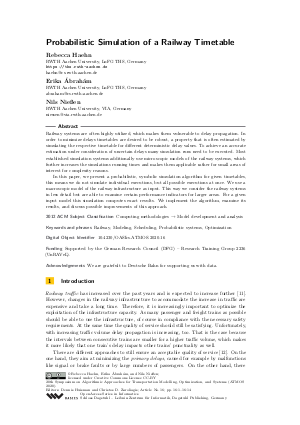@InProceedings{haehn_et_al:OASIcs.ATMOS.2020.16,
author = {Haehn, Rebecca and \'{A}brah\'{a}m, Erika and Nie{\ss}en, Nils},
title = {{Probabilistic Simulation of a Railway Timetable}},
booktitle = {20th Symposium on Algorithmic Approaches for Transportation Modelling, Optimization, and Systems (ATMOS 2020)},
pages = {16:1--16:14},
series = {Open Access Series in Informatics (OASIcs)},
ISBN = {978-3-95977-170-2},
ISSN = {2190-6807},
year = {2020},
volume = {85},
editor = {Huisman, Dennis and Zaroliagis, Christos D.},
publisher = {Schloss Dagstuhl -- Leibniz-Zentrum f{\"u}r Informatik},
address = {Dagstuhl, Germany},
URL = {https://drops.dagstuhl.de/entities/document/10.4230/OASIcs.ATMOS.2020.16},
URN = {urn:nbn:de:0030-drops-131527},
doi = {10.4230/OASIcs.ATMOS.2020.16},
annote = {Keywords: Railway, Modeling, Scheduling, Probabilistic systems, Optimization}
}

 Creative Commons Attribution 3.0 Unported license
Creative Commons Attribution 3.0 Unported license














